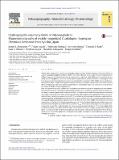Files in this item
Challenging the sensitivity limits of paleomagnetism : magnetostratigraphy of weakly magnetized Guadalupian-Lopingian (Permian) limestone from Kyushu, Japan
Item metadata
| dc.contributor.author | Kirschvink, J.L. | |
| dc.contributor.author | Isozaki, Y. | |
| dc.contributor.author | Shibuya, H. | |
| dc.contributor.author | Otofuji, Y.-I. | |
| dc.contributor.author | Raub, T.D. | |
| dc.contributor.author | Hilburn, I.A. | |
| dc.contributor.author | Kasuya, T. | |
| dc.contributor.author | Yokoyama, M. | |
| dc.contributor.author | Bonifacie, M. | |
| dc.date.accessioned | 2015-03-26T17:31:03Z | |
| dc.date.available | 2015-03-26T17:31:03Z | |
| dc.date.issued | 2015-01-15 | |
| dc.identifier | 159054377 | |
| dc.identifier | ab5ebd10-8bcf-4217-a40f-43e255718d02 | |
| dc.identifier | 84912017947 | |
| dc.identifier | 000349804100007 | |
| dc.identifier.citation | Kirschvink , J L , Isozaki , Y , Shibuya , H , Otofuji , Y-I , Raub , T D , Hilburn , I A , Kasuya , T , Yokoyama , M & Bonifacie , M 2015 , ' Challenging the sensitivity limits of paleomagnetism : magnetostratigraphy of weakly magnetized Guadalupian-Lopingian (Permian) limestone from Kyushu, Japan ' , Palaeogeography, Palaeoclimatology, Palaeoecology , vol. 418 , pp. 75-89 . https://doi.org/10.1016/j.palaeo.2014.10.037 | en |
| dc.identifier.issn | 0031-0182 | |
| dc.identifier.other | ORCID: /0000-0003-4513-2245/work/84315176 | |
| dc.identifier.uri | https://hdl.handle.net/10023/6369 | |
| dc.description.abstract | Despite their utility for bio- and chemostratigraphy, many carbonate platform sequences have been difficult to analyze using paleomagnetic techniques due to their extraordinarily weak natural remanent magnetizations (NRMs). However, the physical processes of magnetization imply that stable NRMs can be preserved that are many orders of magnitude below our present measurement abilities. Recent advances in reducing the noise level of superconducting magnetometer systems, particularly the introduction of DC-SQUID sensors and development of a low-noise sample handling system using thin-walled quartz-glass vacuum tubes, have solved many of these instrumentation problems, increasing the effective sensitivity by a factor of nearly 50 over the previous techniques of SQUID moment magnetometry.Here we report the successful isolation of a two-polarity characteristic remanent magnetization from Middle-Late Permian limestone formed in the atoll of a mid-oceanic paleo-seamount, now preserved in the Jurassic accretionary complex in Japan, which had proved difficult to analyze in past studies. Paleothermometric indicators including Conodont Alteration Indices, carbonate petrology, and clumped isotope paleothermometry are consistent with peak burial temperatures close to 130°C, consistent with rock magnetic indicators suggesting fine-grained magnetite and hematite holds the NRM. The magnetic polarity pattern is in broad agreement with previous global magnetostratigraphic summaries from the interval of the Early-Middle Permian Kiaman Reversed Superchron and the Permian-Triassic mixed interval, and ties the Tethyan-Panthalassan fusuline zones to it. Elevated levels of hematite associated with the positive δC of the Kamura event argue for a brief spike in environmental oxygen. The results also place the paleo-seamount at a paleolatitude of ~12° S, in the middle of the Panthalassan Ocean, and imply a N/NW transport toward the Asian margin of Pangea during Triassic and Jurassic times, in accordance with the predicted trajectory from its tectono-sedimentary background. These developments should expand the applicability of magnetostratigraphic techniques to many additional portions of the Geological time scale. | |
| dc.format.extent | 15 | |
| dc.format.extent | 2656458 | |
| dc.language.iso | eng | |
| dc.relation.ispartof | Palaeogeography, Palaeoclimatology, Palaeoecology | en |
| dc.subject | Paleomagnetism | en |
| dc.subject | Limestone | en |
| dc.subject | Permian | en |
| dc.subject | Kiaman superchron | en |
| dc.subject | Illawarra Reversal | en |
| dc.subject | Mass extinction | en |
| dc.subject | GB Physical geography | en |
| dc.subject | NDAS | en |
| dc.subject.lcc | GB | en |
| dc.title | Challenging the sensitivity limits of paleomagnetism : magnetostratigraphy of weakly magnetized Guadalupian-Lopingian (Permian) limestone from Kyushu, Japan | en |
| dc.type | Journal article | en |
| dc.contributor.institution | University of St Andrews. Earth and Environmental Sciences | en |
| dc.identifier.doi | 10.1016/j.palaeo.2014.10.037 | |
| dc.description.status | Peer reviewed | en |
| dc.identifier.url | http://www.sciencedirect.com/science/article/pii/S0031018214005537#appd001 | en |
This item appears in the following Collection(s)
Items in the St Andrews Research Repository are protected by copyright, with all rights reserved, unless otherwise indicated.

